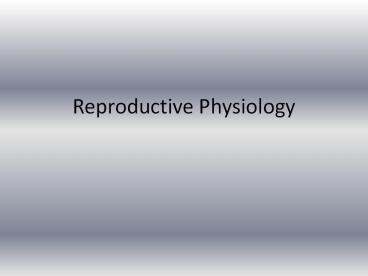Reproductive Physiology PowerPoint PPT Presentation
1 / 27
Title: Reproductive Physiology
1
Reproductive Physiology
2
Topics
- Introduction
- Types of reproduction
- Reproductive cycle
- Sexual behaviour/sexual act (Read Notes)
- Components of sexual act in males (Read Notes)
- Puberty
3
Introduction
- Why do we need to reproduce?
- Important for the propagation of species
- Allows hereditary traits from both parents to be
inherited by offspring
4
Types of Reproduction
5
Reproductive Cycle
Puberty/
Weaning
- Puberty
- Coitus
- Pregnancy
- Parturition
- Lactation
- Weaning
Coitus
Lactation
Pregnancy
Parturition
6
Sexual Behaviour/Sexual Act
- EPOR
- E Excitement Phase (somatogenic or psychogenic
stimulus) - P Plateau Phase (maximum sexual excitement)
- Orgasmic Phase (ejaculation and climax of sexual
excitement with involuntary rhythmic pelvic
muscle contractions lasting a few secs - Resolution phase (resting/refractory phase) in
males, they have to rest before another erection
occurs. In women, this phase will only occur
after multiple orgasms
7
Components of sexual act in males
- Erection
- Ejaculation (Two phases emission and expulsion)
8
Erection
- Engorgement of penis with blood
- Erection reflex - a spinal reflex triggered by
mechanoreceptors on glans penis - Tactile stimulation on glans triggers
parasymphatetic activity - Vasodilation is rapid and full erection achieved
in 5 10 seconds - Bulbourethral gland secretes mucus for
lubrication - Reflex can be stimulated/inhibited by nervous
centre that have the final nervous pathway in the
autonomic nerves (innervates the penile arteriole
e.g., erection can occur due to sight or a
seductive memory without stimulation of glans
penis) - Reflex can also be inhibited even though glans
penis is stimulated e.g., impotence. This
condition is usually more influenced by
psychology rather than physical impairment
(damage to nerve supply that disturbs the
autonomic function and circulation problems to
the penis)
9
Erection reflex Stimulation of
mechanoreceptors in glans penis Parasymphateti
c supply Parasymphatetic supply Symphatetic
to bulbo-urethral to penile
arterioles supply to penile and
urethral glands
arterioles
Mucus Penile arterioles
dilate Lubrication
Erection
Compresses veins
-
-
10
Ejaculation (1)
- A spinal reflex
- Occurs when excitement stage reach a climax
- Consists of two phasesemission phase and
expulsion phase - Emission phase Symphatetic impulse will cause
sequences of smooth muscle contraction at
prostate gland, vas deferens and seminal
vesicles. The prostatic fluid, seminal vesicles
fluid and spermatozoa will drained into urethra
11
Ejaculation (2)
- Expulsion phase The sphincter at the bladder
will close to prevent semen from entering urethra
with urine - Entry of semen into urethra will trigger impulses
that activates skeletal muscles at the base of
the penis - Rhythmic contractions of these muscles (intervals
of 0.8 s) together with pressure on pelvis will
cause ejaculation
12
(No Transcript)
13
Puberty (1)/adolescence
- Morphology, physiology and behavioral changes
that occurs to an individual - Rapid changes of adolescence start gradually, 9
to 11 years old for girls, 13 years old for boys.
- Hormone changes responsible actually begin some
years earlier and may produce periods of
moodiness and restlessness - Girls start these changes before boys and will,
for the first three or four years, appear to be
maturing much faster. - Male growth spurt two years later than female
14
(No Transcript)
15
Physical changes
- Sign of puberty (female) menstruation (first
time), male (first ejaculation usually without
sperm) - After 2-4 years, other changes occurs to the body
and sexual organs - Changes dependent on sex steroids from gonads and
adrenal glands and also growth hormone - Adolescent growth spurt minimum growth
velocity, peak height velocity, decreased growth
velocity and cessation of growth at epiphyseal
fusion - Shoulders broader in men, hips broader in women
- Lean body mass (1.5X gt in males), body fat (2X gt
in females), skeletal mass (1.5X gt in males). Is
that why men are stronger?
16
Secondary Sexual Characteristics
- Growth and development of breasts
- Growth and change in sexual organs
- Monthly periods, vaginal secretions
- Moustache, beard
- Change in voice pitch (lower and deeper in boys)
- Activation of sweat glands (acne and body odour)
- Development of body hairs (auxillary etc) and
pubic hair - Testosterone influences male secondary sexual
characteristics while estrogen is for female - These changes occurs at different age in
different individuals
17
Stages of puberty (females)
18
Stages of puberty (males)
19
Common problem faced by adolescents
- Emotional problems (Depression)
- Sexual Problems
- Boys more aggressive than girls
- Both have sexual desires
- A few years after attaining puberty, if a pair of
adolescents have sex, the girl will become
pregnant - REALLY! YES! REALLY!.this is because the ovaries
have release ova and the testes have produce
spermatozoa - If fertilization occurs, then this will result in
an unwanted pregnancy
20
(No Transcript)
21
(No Transcript)
22
- Behaviour problems
23
(No Transcript)
24
(No Transcript)
25
(No Transcript)
26
- Eating problems
- Drugs, solvents and alcohol
- Abuse
- - Any physical, emotional and sexual abuse may
occur in adolescence and may cause many of the
problems mentioned - Families with these problems need expert advice
and should seek help. - It is important to remember that once a child or
teenager has been subjected to any form of abuse,
they grow up to become abusers themselves
27
Adolescence Health Problems
- High blood pressure
- Glandular fever
- Obesity
- Orthodonthics
- Other health problems when active in sports
- Gynaecological and menstrual problems

